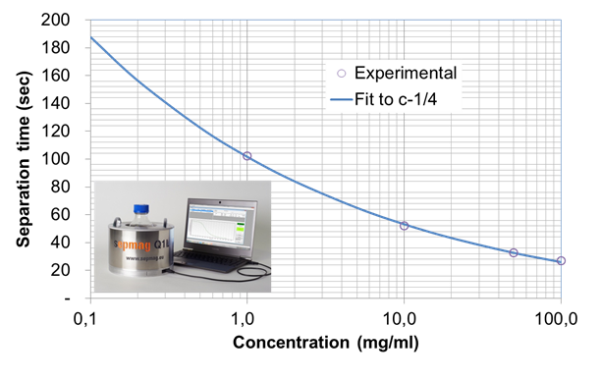In the Life Sciences, one of the most critical parameters for final IVD kit performance is magnetic bead concentration. The beads are functionalized before the magnetic separation process with antibodies or other biological molecules, so the concentration of magnetic beads also delivers a specific concentration of biologically active reagent. If you do not have the correct amount of beads/biological molecules in your preparation, the sensitivity of the kit changes significantly. Therefore volume control of the suspension is quite important.

The typical precision of volume control in laboratory processes in general, is approximately 2%. As the production process is scaled up, volume control becomes even more critical.
This post is about biomagnetic separation in the production of magnetic beads for IVD kits. If you want to know its most important elements, download our free ebook The basic guide to use biomagnetic separation in production processes:
The role of bead-to-bead interactions
Efficient biomagnetic separation processes take advantage of bead-to-bead interactions. Beads interact with their neighbors, forming chains which then decrease the time of separation. Bead-to-bead interactions rely strongly on magnetic bead concentration. The more beads you have, the closer any given bead is to its neighbor and the faster they will interact and form these beneficial chain structures during the separation process. Once chains are formed, the chained structures move faster during separation than individual beads, thus affecting the time of separation. Therefore, not only does a higher concentration cause bead chains to be formed more quickly, it also facilitates a faster speed of separation.
In homogeneous biomagnetic separation, bead speed is proportional to the fourth root of the concentration. Under these conditions, if one monitors the production process, one can detect problems with the bead concentration if the separation time is off from the expected time. In other words, a 10% concentration change in the material can modify the separation time by 2.6%. Therefore, if you make a mistake somehow in creating your suspensions, the behavior of the beads separated with magnetic separation in homogeneous conditions will be very clearly different from the behavior of a suspension with the wrong concentration of beads.
If you found this post about using biomagnetic separation for production useful, don't forget to check these related posts:
- Perfecting the magnetic separation process in magnetic bead IVD kit production
- Problems that stem from linking your production process to a specific type of equipment
- Issues with magnetic beads lot-to-lot inconsistent properties
Check www.sepmag.eu/ebooks to access to FREE eBooks on the subject, or contact us. We will be glad to help you to achieve an efficient magnetic bead separation process!





